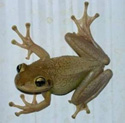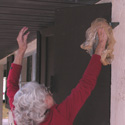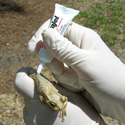Invasive Cuban Treefrogs in Florida
Are Your Treefrogs Invasive Cuban Treefrogs?
The Cuban Treefrog can be tough to identify. These invasive frogs can be white, gray, green, or brown, and can change colors. Some Cuban Treefrogs have dark streaks or splotches on their backs, while others are nearly solid color with no markings. To see photos of Cuban Treefrogs and learn tips on how to identify them, check out :
Florida is also home to several native treefrogs -- be sure to check out the link on the left for 'Florida's Frogs' to view information about native treefrogs and other frogs.
Cuban Treefrog -- Annoying Pest!
The Cuban Treefrog (Osteopilus septentrionalis) is native to Cuba, the Cayman Islands and the Bahamas. These treefrogs were accidentally brought to Florida in the 1920s, probably as hitchhikers in cargo containers on ships. Cuban Treefrogs are considered invasive in Florida (and other tropical areas) because they are likely to harm our native ecosystems and also cause a lot of problems for humans. Cuban Treefrogs eat at least five different species of native frogs, not to mention the occasional lizard or small snake, and their tadpoles compete with native tadpoles for space and food. Cuban Treefrogs are common in urban areas, where they hang out near lights on the walls of houses and catch insects. They often poop on walls and windows (leaving ugly stains), take over birdhouses, and lay eggs in fish ponds and bird baths. Sometimes Cuban Treefrogs even find their way into homes, hanging out in toilets and clogging sink drains. Cuban treefrogs grow very large, and are known to cause costly power outages by short-circuiting utility switches. Our native treefrogs are all much smaller, and aren't known to cause such utility problems.
To learn more about Cuban Treefrogs, read "The Cuban Treefrog in Florida".
What Can You Do?
If you find a Cuban Treefrog at your house, check the Cuban Treefrog range map and report sightings in new areas. Most importantly, you can also help by managing Cuban Treefrogs around your home. Capture Cuban Treefrogs in a plastic bag to avoid contact with the 'slime' secreted by their skin -- it can irritate your nose and eyes, and may trigger attacks in asthma sufferers. After you capture the frog, we recommend that you euthanize them humanely -- in fact, it is illegal (and irresponsible) to re-release them into our ecosystem. The most humane way to euthanize Cuban Treefrogs is by liberally applying benzocaine (20%) to the back or belly of the frog. At your local drugstore, you can find a variety of products containing 20% benzocaine -- first aid or burn sprays and toothache gels or liquids. After you apply the benzocaine, the Cuban Treefrog will quickly become unconscious. Next, seal the plastic bag and put it into the freezer overnight. By the next day, you can be sure that the Cuban Treefrog will not wake up (which would be inhumane), and can dispose of the bag.
At this point, it is important to note that the Cuban Treefrog IS an interesting creature. Amazing adaptations help them avoid drying out or being eaten by predators -- the irritating skin secretions are a great example of this. Unfortunately, human activities have resulted in the accidental introduction of Cuban Treefrogs in Florida and other tropical and subtropical areas. Every day, we receive reports of Cuban Treefrogs found in ornamental plants -- some as far away as Canada! In Florida, the presence of this frog is NOT benign -- they are quite literally eating our native species alive, adding pressure to species that are already greatly affected by habitat loss. It is for these reasons that we advocate humanely euthanizing invasive Cuban Treefrogs -- help give our native wildlife a break!
Cuban Treefrog Research at UF
Dr. Steve Johnson is involved in a variety of research projects focused on increasing our knowledge of invasive Cuban Treefrogs, understanding its impacts on native species, and investigating potential control methods. This research includes testing of a Cuban treefrog deterrent that may help to keep them from using enclosed refuges such as utility boxes. Follow the links on the left under "Research" to learn more.
 Invasive Cuban Treefrog
Invasive Cuban Treefrog
 Catching Cuban Treefrogs
Catching Cuban Treefrogs
 Euthanizing Cuban Treefrogs
Euthanizing Cuban Treefrogs